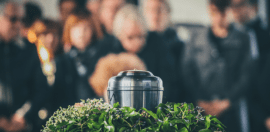Connecting in a crisis

29 September 2020 at 8:00 am
In an extract from their new book, Reconnected: A community builder’s handbook, Andrew Leigh and Nick Terrell consider how large-scale emergencies boost social capital, and how recent crises have shown Australians are ready to help their neighbours.
On 21 December 2019, as residents in the Adelaide Hills prepared for the arrival of a fire front that would kill two people, injure 23 firefighters and destroy 72 homes, 76-year-old Denis Noble and his wife were monitoring the advance of the front, watching flames rolling steadily over a nearby hill and down towards their home. They had moved into the area just the previous week.
When the flames began to take hold in an open paddock that led up to their residential street, an energetic posse of neighbours quickly came together to form a bucket brigade that ultimately halted the fire’s advance at the road line. Noble described how “it came slowly, inexorably towards us… we’re oldies. They’re full of energy and tearing around with buckets. Everybody pitched in to stop the fire and it stopped at the roadway. It was a good way to get to know the new neighbours.” This was a dramatic introduction to a new home base, but also a deeply affecting experience of gratitude and fellowship with a new community.
Large-scale emergencies boost social capital. When the fire season of 2019-20 started to consume townships and displace communities around coastal New South Wales, East Gippsland and the Adelaide Hills, the outpouring of community assistance initially outpaced the official offerings. Social media campaigns to generate money and accommodation took off. Community organisations and spontaneous informal collectives organised donation points for essential items (water, food, clothing) and partnered with small-scale voluntary logistics operations to get assistance to people who’d been forced to flee from their homes. Facebook and Twitter hummed with updates from the fire fronts and with earnest outpourings of helpfulness from concerned people looking on from afar.
Organic and anarchic, every good turn prompted more. At times, the well-intentioned assistance created organisational and logistical headaches for relief operations. A community in East Gippsland received about 10,000 apples. They really needed money. In other communities, donations of clothes, furniture and toys clogged up community halls, leading Jeremy Hillman from the NSW Office of Emergency Management to warn, “We see all over New South Wales that these halls get filled up to the roof, and at the same time the community has nowhere to come together while it’s full.”
Huge numbers of people were expressing, and maybe discovering for the first time, a desire to do something good for people they would never meet. But without the right systems in place, the chance to translate that spontaneous altruism into a lasting volunteering ethos would be missed.
When it comes to measuring the benefits social capital can generate for individuals and their communities, disaster response and recovery is one of the better researched fields. Disaster-prone areas tend to have firmly established routines of communal response. Economist Aitor Calo-Blanco and his collaborators looked at a range of regional areas in Chile with varying exposure to earthquake activity and found that “social cohesion increases after a big earthquake and slowly erodes in periods where environmental conditions are less adverse”. Drawing on research around other disaster scenarios, they noted that when disaster struck, people had a tendency “to create networks associated with higher social cohesion”. Disasters hit a community indiscriminately and all at once, short-circuiting the usual evaluation humans make about who deserves our help and whether a favour will be returned.
There’s a Darwinian rationalisation for this process, with communities in adverse locations needing to cooperate to survive. The Chilean study concluded that “exposure to earthquakes seems to be consistently associated with higher levels of positive and lower levels of negative social cohesion indicators”. People gave more to charity, volunteered more, and were more likely to vote. They were less likely to engage in crime and reported higher life satisfaction. The effects erode gradually as the earthquake recedes into memory, suggesting the crisis point was a factor in these changes.
A similar pattern occurred in the United States after the terrorist attacks on 11 September 2001, which killed almost 3,000 people. Social capital surveys before and after the attacks found that Americans were 6 per cent more likely to have worked on community projects. They were also more trusting of government, co-workers and neighbours. But these effects faded out over the subsequent years. Unlike the way that World War II moulded the lifetime volunteering habits of the birth cohort sometimes dubbed “the greatest generation”, the September 11 terrorist attacks did not leave a lasting impact on social capital in America.
To optimise resilience and recovery, Japanese local government areas have learnt that where evacuees need temporary resettlement, they should be kept in groupings that maintain local bonds. Organised activities and volunteering can strengthen social networks among disaster-affected residents and help them maintain morale. The activity could be a tea ceremony or having an elderly resident tell a story to a group of children. One study found that regular attendees gained around one extra friend above the average. Their sense of agency and belonging increased. Participants were more likely to share their opinion in public meetings, vote, and interact with elected officials.
Such studies suggest that low-cost social infrastructure investments can have better returns than physical infrastructure. The challenge is to build smart structures that turn disaster-inspired altruism into volunteering efforts that are useful in the short-term and benefit the community in the long-term.
COVID-19 generated a range of spontaneous social infrastructure. In coastal Northern New South Wales, Bellingen Shire Council’s preparation for the oncoming challenges of the pandemic provides a good example of how local organisations can help small community units form into a regional web. The Bellingen Shire Pandemic Response Group was created in early March as a precautionary collaboration to prepare the community for possible upheavals across social support, clinical services, council activity and local business. The group was administered and resourced through the council, and guided by community members.
“It’s all about helping the community help itself,” explained the facilitator, Dean Besley. “We don’t know what we’re facing, we just know we’re better if we do it together.” The Response Group gave a role to each of the major sectors in the town – health, council, business – and created a new Neighbourhood Care Network specifically to sustain connection and social support. A radio ad told shire residents, “the more of us who register, the easier it will be to get help for people who really need it. And this will be important if things do really get tough”. Local “Champions” were encouraged to take initiative in their area and set up neighbourhood networks of about 50 people: large enough to spread the load, but small enough to make communication simple – through emails, text messages or Facebook. The Council hopes that the preparation has strengthened the district’s resilience, making it a safer and more connected community.
We’ll return to some other examples of COVID-driven volunteering in the final chapter, but for now, it’s worth noting that Bellingen Shire Council’s response both addressed an immediate need and helped build resilience. This kind of positive synergy needs its own name. In his dystopian novel 1984, George Orwell imagined a world in which a totalitarian regime had replaced all superlatives with the word “double-plus-good”. We think it’s time to repurpose Orwell’s Newspeak term for a more positive purpose. When community groups deliver a dual benefit, we call it “doing double-plus-good”. Because setting up and maintaining local resilience networks strengthens local ties, it’s double-plus-good.
Extract taken from Reconnected: A Community Builder’s Handbook by Andrew Leigh and Nick Terrell. OUT NOW via Booktopia or wherever good books are sold.
In Reconnected, Andrew Leigh and Nick Terrell look at some of the most successful community organisations and initiatives – from conversation groups to community gardens, from parkrun to Pub Choir – to discover what really works. They explore ways to encourage philanthropy and volunteering, describe how technology can be used effectively, and introduce us to remarkable and inspirational leaders. Reconnected is an essential guide for anyone interested in strengthening social ties.
Giveaway! Enter your details for a chance to win one of five copies of this book.
The competition has now ended. Thank you to all our entrants and congratulations to the winners! The winners were notified by email on Monday 12 October.








